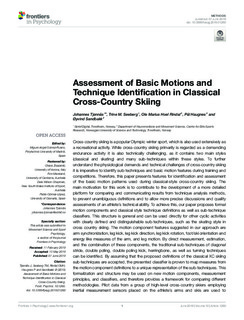| dc.description.abstract | Cross-country skiing is a popular Olympic winter sport, which is also used extensively as a recreational activity. While cross-country skiing primarily is regarded as a demanding endurance activity it is also technically challenging, as it contains two main styles (classical and skating) and many sub-techniques within these styles. To further understand the physiological demands and technical challenges of cross-country skiing it is imperative to identify sub-techniques and basic motion features during training and competitions. Therefore, this paper presents features for identification and assessment of the basic motion patterns used during classical-style cross-country skiing. The main motivation for this work is to contribute to the development of a more detailed platform for comparing and communicating results from technique analysis methods, to prevent unambiguous definitions and to allow more precise discussions and quality assessments of an athlete's technical ability. To achieve this, our paper proposes formal motion components and classical style technique definitions as well as sub-technique classifiers. This structure is general and can be used directly for other cyclic activities with clearly defined and distinguishable sub-techniques, such as the skating style in cross country skiing. The motion component features suggested in our approach are arm synchronization, leg kick, leg kick direction, leg kick rotation, foot/ski orientation and energy like measures of the arm, and leg motion. By direct measurement, estimation, and the combination of these components, the traditional sub-techniques of diagonal stride, double poling, double poling kick, herringbone, as well as turning techniques can be identified. By assuming that the proposed definitions of the classical XC skiing sub-techniques are accepted, the presented classifier is proven to map measures from the motion component definitions to a unique representation of the sub-techniques. This formalization and structure may be used on new motion components, measurement principles, and classifiers, and therefore provides a framework for comparing different methodologies. Pilot data from a group of high-level cross-country skiers employing inertial measurement sensors placed on the athlete's arms and skis are used to demonstrate the approach. The results show how detailed sub-technique information can be coupled with physical, track, and environmental data to analyze the effects of specific motion patterns, to develop useful debriefing tools for coaches and athletes in training and competition settings, and to explore new research hypotheses. | nb_NO |
| dc.description.localcode | Copyright © 2019 Tjønnås, Seeberg, Rindal, Haugnes and Sandbakk. This is an open-access article distributed under the terms of the Creative Commons Attribution License (CC BY). The use, distribution or reproduction in other forums is permitted, provided the original author(s) and the copyright owner(s) are credited and that the original publication in this journal is cited, in accordance with accepted academic practice. No use, distribution or reproduction is permitted which does not comply with these terms. | nb_NO |

